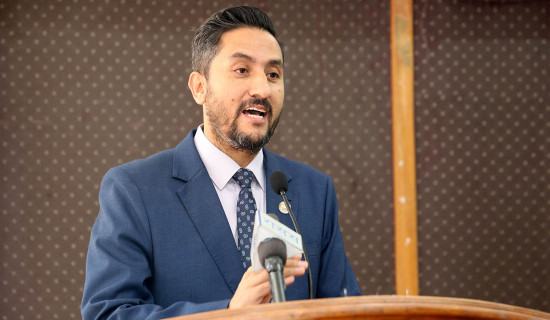- Wednesday, 17 December 2025
Safety Measures Missing In Construction Sector
This writer personally witnessed a horrifying incident right before my eyes: a construction worker fell from a three-story building in the neighbourhood, resulting in a severe torso injury upon impact. Within moments, another worker suffered leg injuries when a pile of debris collapsed and struck him. It is not an exaggeration to state that such occurrences are distressingly common in Nepal. These accidents could have been prevented or at least minimised, had proper safety protocols been followed. However, what is truly astonishing is that the disregard for safety protocols is pervasive across construction sites in Nepal.
Wherever I go in the country, I come across job sites where workers are endangering their lives due to the absence of fundamental safety measures. Welders operate without wearing safety goggles, roofers perform their tasks wearing inadequate footwear, and masons continue their work without protective headgear. Additionally, it is not uncommon to observe children wandering around these hazardous environments. It is genuinely alarming to witness such flagrant negligence in a country experiencing rapid growth in the construction industry. Nepal's construction industry has indeed witnessed significant expansion in recent years, with the construction of new buildings, infrastructure projects, and maintenance and repair work becoming increasingly common.
Perilous conditions
However, amidst this rapid development, the critical issue of ensuring basic safety lessons in the construction sector has been largely overlooked. Workers are subjected to perilous conditions without any protective gear, and safety measures are non-existent. One of the most glaring issues in the Nepali construction industry is the lack of comprehensive safety training for workers. Many labourers, particularly those from poor and marginalised backgrounds, are often less educated and unskilled and unaware of basic safety measures. They are frequently employed without proper safety induction or training, putting their lives at risk.
This absence of training not only endangers the workers but also compromises the overall quality of construction projects. Negligence of protective gear is another utmost concern in the industry. Personal protective equipment (PPE) is a fundamental aspect of ensuring worker safety in construction sites. However, its usage remains alarmingly low in Nepal. Hard hats, safety goggles, gloves, and sturdy footwear are often overlooked, exposing workers to potentially fatal accidents. The absence of a safety culture, coupled with a lack of enforcement by regulatory bodies, contributes to this neglect of protective gear.
Accidents and fatalities could be substantially minimised if construction projects often had proper supervision and monitoring systems in place, suppressing unsafe practices to persist. The absence of site supervisors or inspectors results in workers cutting corners, compromising safety standards, and increasing the risk of accidents. Moreover, inadequate monitoring by regulatory authorities contributes to a culture of non-compliance with safety regulations. The legal aspect and its enforcement appear somewhat unclear. Recently, the government introduced the National Occupational Safety and Health Policy 2020, aimed at establishing healthy, safe, organised, and dignified workplaces. Additionally, the Nepal Building Code (NBC) includes Construction Safety (NBC 114: 1994) as part of its safety requirements.
Although these safety regulations and guidelines exist, their implementation and enforcement are weak. The government should strengthen its legislative framework and ensure strict adherence to safety regulations. It is essential to increase inspections, impose penalties for non-compliance, and establish robust monitoring mechanisms to promote safety in the construction industry. Furthermore, there is a pressing need to develop a comprehensive Occupational Safety and Health Legislative Framework, along with administrative and enforcing bodies that align with internationally recognised standards such as the Occupational Safety and Health Administration (OSHA) in the United States. OSHA is a federal agency committed to safeguarding worker health and safety, serving as a model that is respected and replicated worldwide.
Proper management
Lastly, it is important to address the deplorable state of worksite organisation within the construction industry. The proper organisation and management of worksites are vital in upholding safety standards. Regrettably, in Nepal, worksite organisation frequently fails to meet the necessary requirements. Hazardous materials are improperly stored, machinery and equipment receive insufficient maintenance, and work areas are kept in a highly disorderly state. The absence of basic safety lessons within the Nepali construction industry is a pressing concern that demands immediate attention. Without proper safety training, the lives of workers remain at risk, and the quality and sustainability of construction projects are compromised.
The government, industry stakeholders, and regulatory bodies must collaborate to address this issue by implementing comprehensive safety training programmes, enforcing the use of personal protective equipment, improving worksite organisation, and enhancing supervision and monitoring practices. Additionally, a commitment to strengthening legislation and enforcement will be instrumental in fostering a culture of safety within the industry. Only through these concerted efforts can we ensure a safer future for workers and a thriving construction industry in Nepal.
(Dr. Puri holds a PhD in structural engineer from Tokyo University and a postdoc from the University of Illinois at Urbana-Champaign, USA.)
















